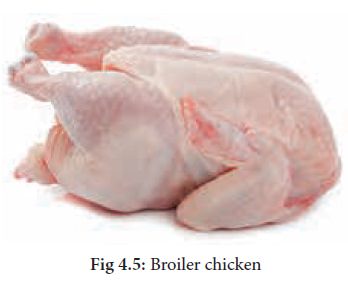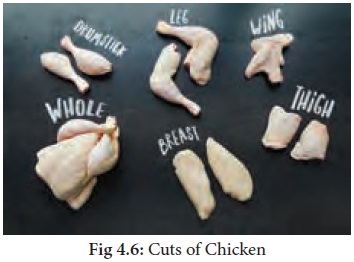Classification, Processing, Composition and nutritive value, Selection - Poultry | 11th Nutrition and Dietetics : Chapter 4 : Flesh Foods, Milk and Milk Products
Chapter: 11th Nutrition and Dietetics : Chapter 4 : Flesh Foods, Milk and Milk Products
Poultry
Poultry
The term poultry is
applied to all domesticated birds used as food and includes chicken, ducks,
geese, turkeys and pigeons. Of these, chicken and turkey are most commonly used
for their meat.

Classification
Poultry is classified
based on age. Age influences tenderness and fat content of the poultry.
According to Indian standards, the classification is as follows:
Broiler or fryer: Chicken of 8 to 10
weeks of age either sex, having tender meat with soft, pliable smooth textured
skin and flexible breastbone cartilage.
Roaster: A young chicken,
usually 3 to 5 month of age, of either sex, having tender meat with soft,
pliable smooth textured skin and breastbone cartilage that may be somewhat less
flexible that of the broiler or fryer.
Stag: A male chicken,
usually under 10 months of age with coarse skin, somewhat toughened and
darkened flesh and a considerable hardening of the breastbone cartilage.
Stewing chicken or
fowl: A
mature chicken, usually more than 10 months of age, with meat less tender than
that of a roaster and inflexible breastbone tip.
Cock: A mature male chicken,
usually over 10 months of age, with coarse skin, toughened and darkened meat
and hardened breastbone tip.
Processing
Poultry is marketed in
ready to cook form as dressed chicken after removing the head, feet and
entrails. After the birds are killed, they are scalded, that is, dipped in hot
water briefly. The temperature of the scald water may be 60 0C and
the bird is kept in it for about 45 seconds or more. Scalding loosens the
feathers on the chicken and thus helps defeathering.

After defeathering,
evisceration of the bird takes place. The eviscerated birds are thoroughly
washed and chilled. Chicken can be purchased whole, cut into parts or in packs
of similar individual parts, such as breasts, drum sticks or thighs.
Composition and nutritive value
Poultry meat has high
protein content (about 25 percent) and is comparable in quality and nutritive
value to other meats. It contains all the essential amino acids required for
building body tissues. There is a little fat on the meat of young birds, but
the fat content is influenced by age and species of poultry.

Chicken fat is more
unsaturated than the fat of red meat and this has nutritional advantage.
Because of its high protein to fat ratio, poultry meat is advantageous to
persons who must restrict the intake of fats. Like other animal tissues,
poultry flesh is a good source of B Vitamins and minerals.
Selection of poultry
When purchasing fresh
poultry, look for firm birds with plump flesh the skin should not look
wrinkled. If buying frozen chicken, check that the package is well sealed.
Related Topics